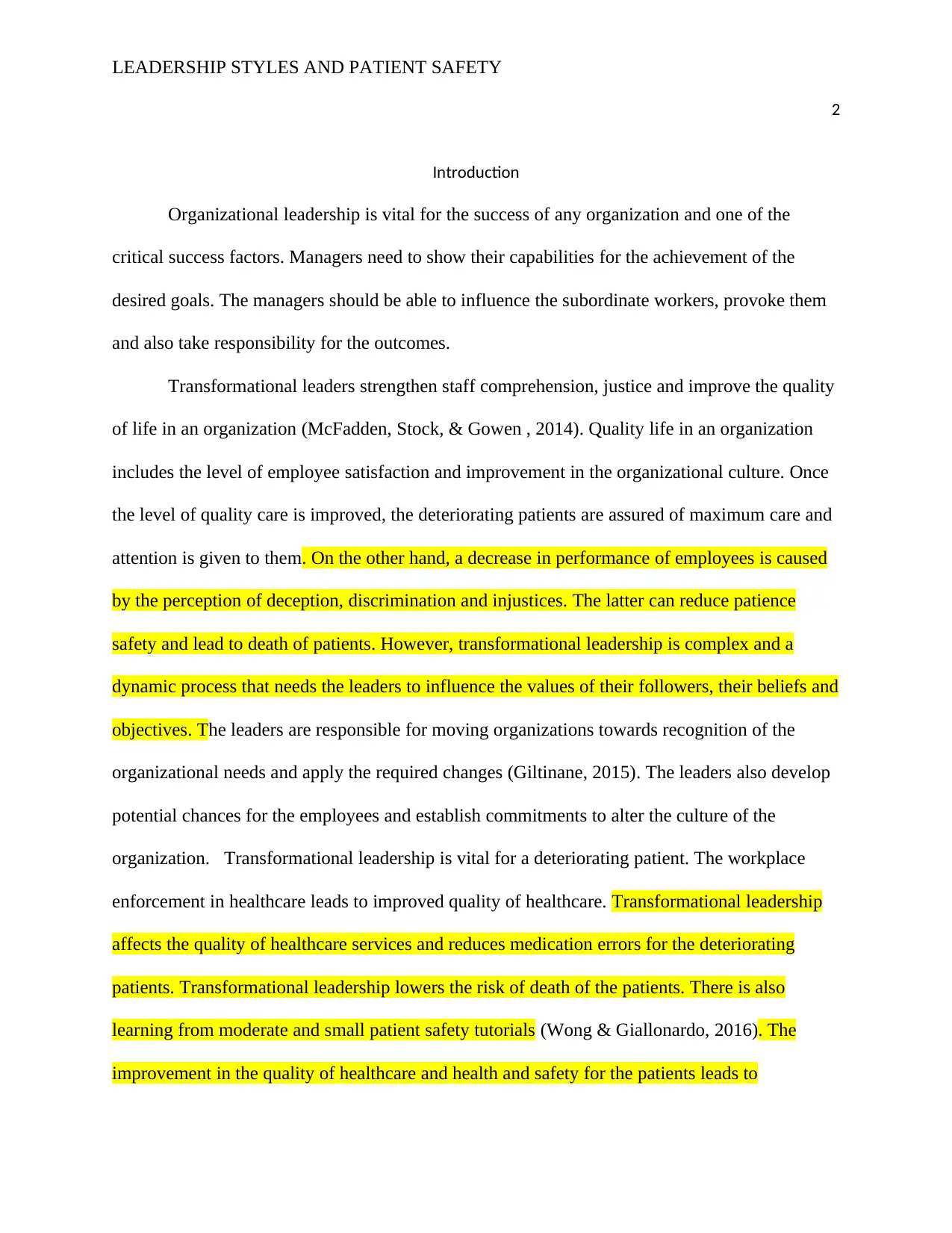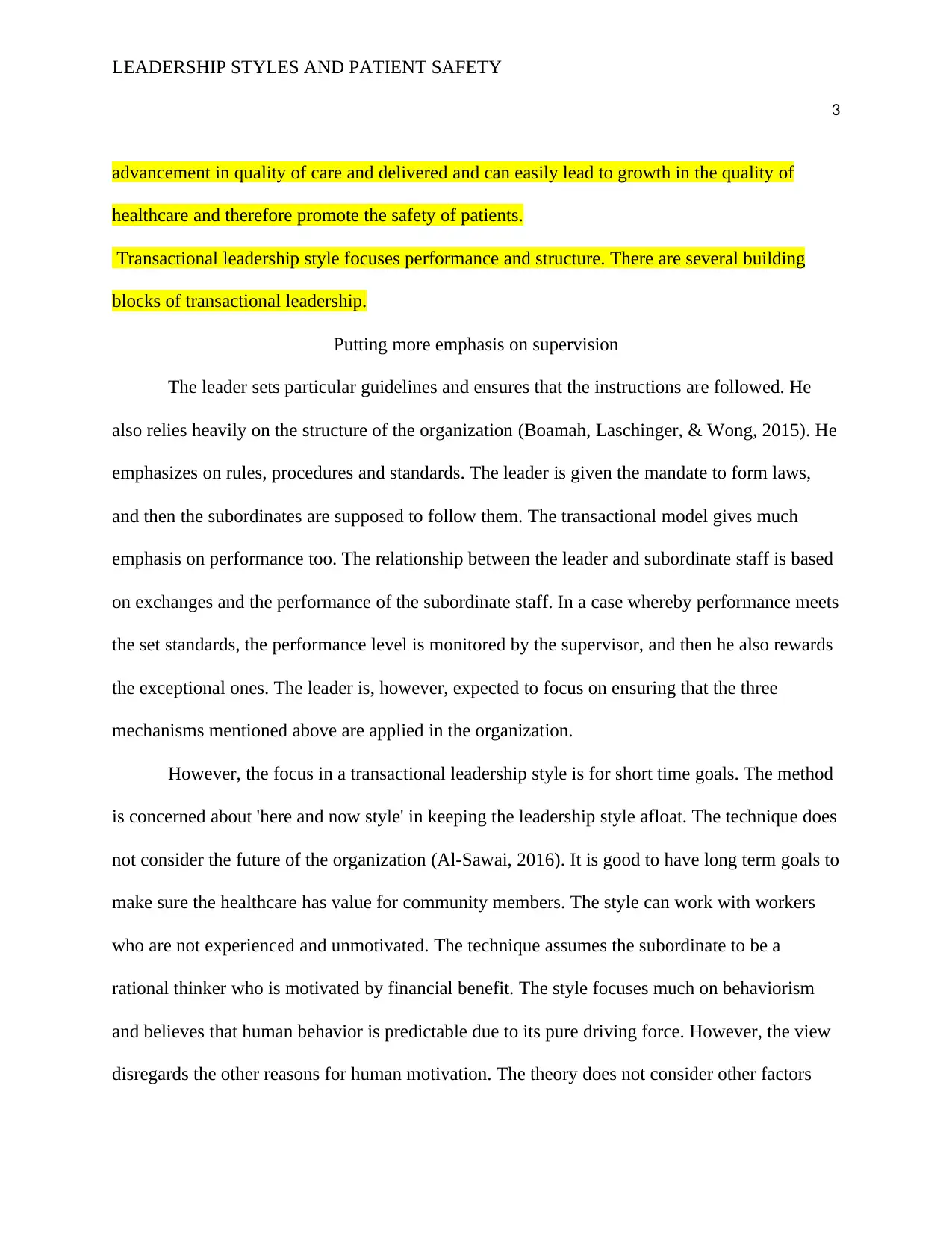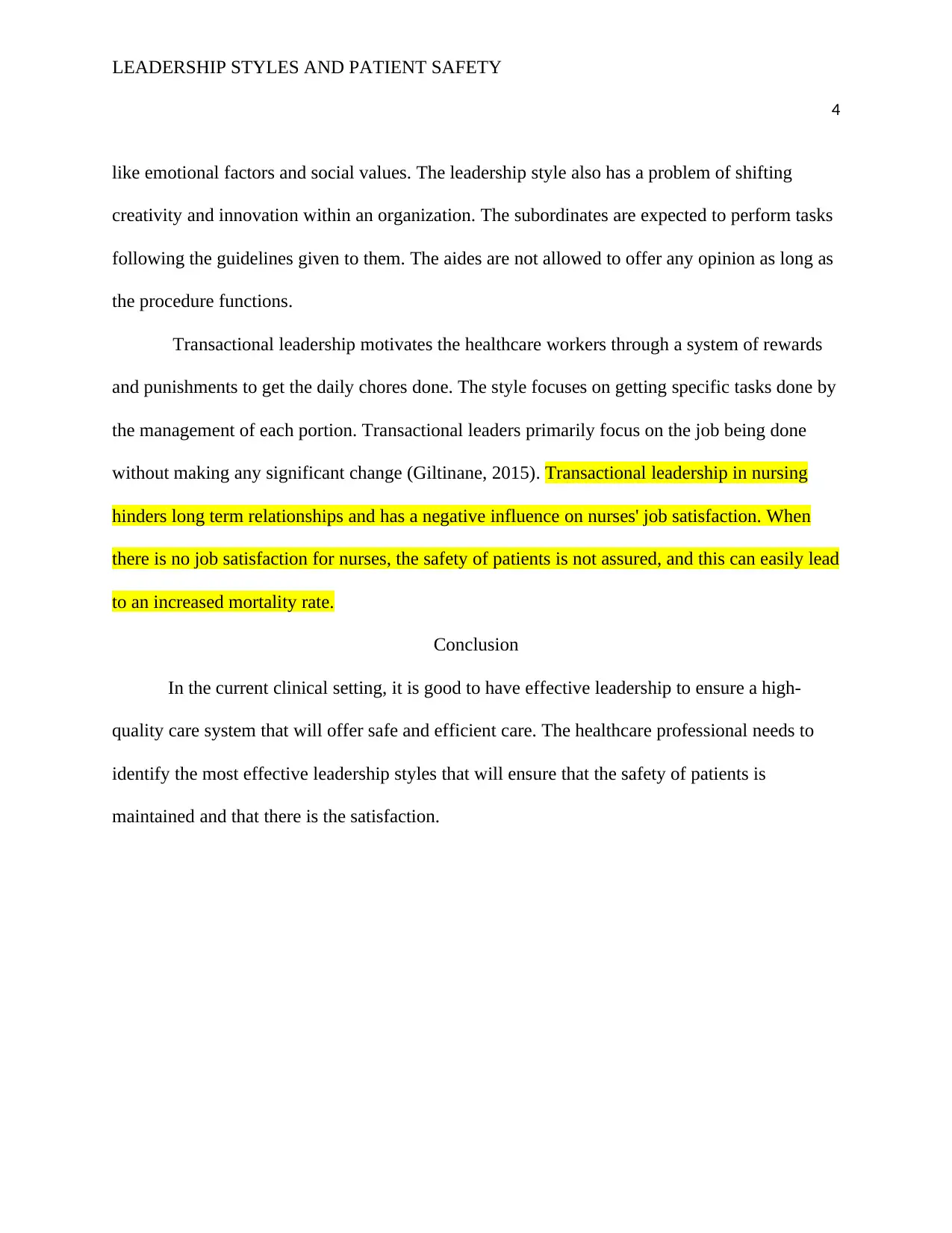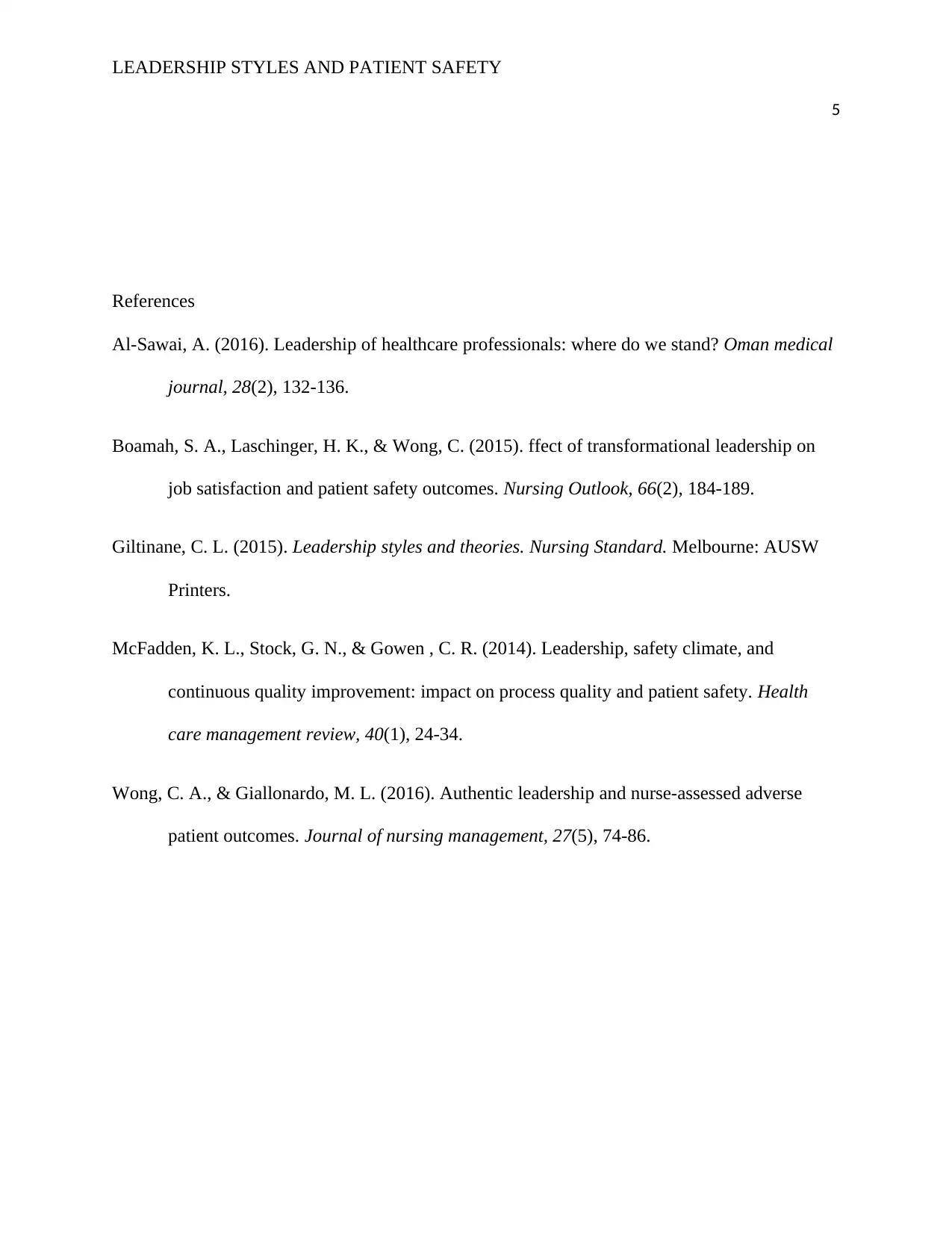Analysis of Leadership Styles and Their Impact on Patient Safety
VerifiedAdded on 2022/12/29
|5
|1069
|49
Essay
AI Summary
This essay delves into the critical role of leadership styles in ensuring patient safety within healthcare settings. It contrasts transformational and transactional leadership approaches, highlighting their respective impacts on organizational culture, employee satisfaction, and patient outcomes. Transformational leadership is presented as a method that strengthens staff comprehension, justice, and improves the quality of life in an organization, leading to improved healthcare quality and reduced medication errors for deteriorating patients. The essay also examines the transactional leadership style, focusing on its emphasis on performance, structure, and short-term goals, as well as its potential limitations in fostering long-term relationships and innovation. The conclusion emphasizes the need for effective leadership to maintain high-quality care systems and promote patient safety. The references include several academic sources that support the arguments presented.

Running Head: LEADERSHIP STYLES AND PATIENT SAFETY
LEADERSHIP STYLES AND PATIENT SAFETY
Name
Professor
Institution
Course
Date
LEADERSHIP STYLES AND PATIENT SAFETY
Name
Professor
Institution
Course
Date
Paraphrase This Document
Need a fresh take? Get an instant paraphrase of this document with our AI Paraphraser

LEADERSHIP STYLES AND PATIENT SAFETY
2
Introduction
Organizational leadership is vital for the success of any organization and one of the
critical success factors. Managers need to show their capabilities for the achievement of the
desired goals. The managers should be able to influence the subordinate workers, provoke them
and also take responsibility for the outcomes.
Transformational leaders strengthen staff comprehension, justice and improve the quality
of life in an organization (McFadden, Stock, & Gowen , 2014). Quality life in an organization
includes the level of employee satisfaction and improvement in the organizational culture. Once
the level of quality care is improved, the deteriorating patients are assured of maximum care and
attention is given to them. On the other hand, a decrease in performance of employees is caused
by the perception of deception, discrimination and injustices. The latter can reduce patience
safety and lead to death of patients. However, transformational leadership is complex and a
dynamic process that needs the leaders to influence the values of their followers, their beliefs and
objectives. The leaders are responsible for moving organizations towards recognition of the
organizational needs and apply the required changes (Giltinane, 2015). The leaders also develop
potential chances for the employees and establish commitments to alter the culture of the
organization. Transformational leadership is vital for a deteriorating patient. The workplace
enforcement in healthcare leads to improved quality of healthcare. Transformational leadership
affects the quality of healthcare services and reduces medication errors for the deteriorating
patients. Transformational leadership lowers the risk of death of the patients. There is also
learning from moderate and small patient safety tutorials (Wong & Giallonardo, 2016). The
improvement in the quality of healthcare and health and safety for the patients leads to
2
Introduction
Organizational leadership is vital for the success of any organization and one of the
critical success factors. Managers need to show their capabilities for the achievement of the
desired goals. The managers should be able to influence the subordinate workers, provoke them
and also take responsibility for the outcomes.
Transformational leaders strengthen staff comprehension, justice and improve the quality
of life in an organization (McFadden, Stock, & Gowen , 2014). Quality life in an organization
includes the level of employee satisfaction and improvement in the organizational culture. Once
the level of quality care is improved, the deteriorating patients are assured of maximum care and
attention is given to them. On the other hand, a decrease in performance of employees is caused
by the perception of deception, discrimination and injustices. The latter can reduce patience
safety and lead to death of patients. However, transformational leadership is complex and a
dynamic process that needs the leaders to influence the values of their followers, their beliefs and
objectives. The leaders are responsible for moving organizations towards recognition of the
organizational needs and apply the required changes (Giltinane, 2015). The leaders also develop
potential chances for the employees and establish commitments to alter the culture of the
organization. Transformational leadership is vital for a deteriorating patient. The workplace
enforcement in healthcare leads to improved quality of healthcare. Transformational leadership
affects the quality of healthcare services and reduces medication errors for the deteriorating
patients. Transformational leadership lowers the risk of death of the patients. There is also
learning from moderate and small patient safety tutorials (Wong & Giallonardo, 2016). The
improvement in the quality of healthcare and health and safety for the patients leads to

LEADERSHIP STYLES AND PATIENT SAFETY
3
advancement in quality of care and delivered and can easily lead to growth in the quality of
healthcare and therefore promote the safety of patients.
Transactional leadership style focuses performance and structure. There are several building
blocks of transactional leadership.
Putting more emphasis on supervision
The leader sets particular guidelines and ensures that the instructions are followed. He
also relies heavily on the structure of the organization (Boamah, Laschinger, & Wong, 2015). He
emphasizes on rules, procedures and standards. The leader is given the mandate to form laws,
and then the subordinates are supposed to follow them. The transactional model gives much
emphasis on performance too. The relationship between the leader and subordinate staff is based
on exchanges and the performance of the subordinate staff. In a case whereby performance meets
the set standards, the performance level is monitored by the supervisor, and then he also rewards
the exceptional ones. The leader is, however, expected to focus on ensuring that the three
mechanisms mentioned above are applied in the organization.
However, the focus in a transactional leadership style is for short time goals. The method
is concerned about 'here and now style' in keeping the leadership style afloat. The technique does
not consider the future of the organization (Al-Sawai, 2016). It is good to have long term goals to
make sure the healthcare has value for community members. The style can work with workers
who are not experienced and unmotivated. The technique assumes the subordinate to be a
rational thinker who is motivated by financial benefit. The style focuses much on behaviorism
and believes that human behavior is predictable due to its pure driving force. However, the view
disregards the other reasons for human motivation. The theory does not consider other factors
3
advancement in quality of care and delivered and can easily lead to growth in the quality of
healthcare and therefore promote the safety of patients.
Transactional leadership style focuses performance and structure. There are several building
blocks of transactional leadership.
Putting more emphasis on supervision
The leader sets particular guidelines and ensures that the instructions are followed. He
also relies heavily on the structure of the organization (Boamah, Laschinger, & Wong, 2015). He
emphasizes on rules, procedures and standards. The leader is given the mandate to form laws,
and then the subordinates are supposed to follow them. The transactional model gives much
emphasis on performance too. The relationship between the leader and subordinate staff is based
on exchanges and the performance of the subordinate staff. In a case whereby performance meets
the set standards, the performance level is monitored by the supervisor, and then he also rewards
the exceptional ones. The leader is, however, expected to focus on ensuring that the three
mechanisms mentioned above are applied in the organization.
However, the focus in a transactional leadership style is for short time goals. The method
is concerned about 'here and now style' in keeping the leadership style afloat. The technique does
not consider the future of the organization (Al-Sawai, 2016). It is good to have long term goals to
make sure the healthcare has value for community members. The style can work with workers
who are not experienced and unmotivated. The technique assumes the subordinate to be a
rational thinker who is motivated by financial benefit. The style focuses much on behaviorism
and believes that human behavior is predictable due to its pure driving force. However, the view
disregards the other reasons for human motivation. The theory does not consider other factors
⊘ This is a preview!⊘
Do you want full access?
Subscribe today to unlock all pages.

Trusted by 1+ million students worldwide

LEADERSHIP STYLES AND PATIENT SAFETY
4
like emotional factors and social values. The leadership style also has a problem of shifting
creativity and innovation within an organization. The subordinates are expected to perform tasks
following the guidelines given to them. The aides are not allowed to offer any opinion as long as
the procedure functions.
Transactional leadership motivates the healthcare workers through a system of rewards
and punishments to get the daily chores done. The style focuses on getting specific tasks done by
the management of each portion. Transactional leaders primarily focus on the job being done
without making any significant change (Giltinane, 2015). Transactional leadership in nursing
hinders long term relationships and has a negative influence on nurses' job satisfaction. When
there is no job satisfaction for nurses, the safety of patients is not assured, and this can easily lead
to an increased mortality rate.
Conclusion
In the current clinical setting, it is good to have effective leadership to ensure a high-
quality care system that will offer safe and efficient care. The healthcare professional needs to
identify the most effective leadership styles that will ensure that the safety of patients is
maintained and that there is the satisfaction.
4
like emotional factors and social values. The leadership style also has a problem of shifting
creativity and innovation within an organization. The subordinates are expected to perform tasks
following the guidelines given to them. The aides are not allowed to offer any opinion as long as
the procedure functions.
Transactional leadership motivates the healthcare workers through a system of rewards
and punishments to get the daily chores done. The style focuses on getting specific tasks done by
the management of each portion. Transactional leaders primarily focus on the job being done
without making any significant change (Giltinane, 2015). Transactional leadership in nursing
hinders long term relationships and has a negative influence on nurses' job satisfaction. When
there is no job satisfaction for nurses, the safety of patients is not assured, and this can easily lead
to an increased mortality rate.
Conclusion
In the current clinical setting, it is good to have effective leadership to ensure a high-
quality care system that will offer safe and efficient care. The healthcare professional needs to
identify the most effective leadership styles that will ensure that the safety of patients is
maintained and that there is the satisfaction.
Paraphrase This Document
Need a fresh take? Get an instant paraphrase of this document with our AI Paraphraser

LEADERSHIP STYLES AND PATIENT SAFETY
5
References
Al-Sawai, A. (2016). Leadership of healthcare professionals: where do we stand? Oman medical
journal, 28(2), 132-136.
Boamah, S. A., Laschinger, H. K., & Wong, C. (2015). ffect of transformational leadership on
job satisfaction and patient safety outcomes. Nursing Outlook, 66(2), 184-189.
Giltinane, C. L. (2015). Leadership styles and theories. Nursing Standard. Melbourne: AUSW
Printers.
McFadden, K. L., Stock, G. N., & Gowen , C. R. (2014). Leadership, safety climate, and
continuous quality improvement: impact on process quality and patient safety. Health
care management review, 40(1), 24-34.
Wong, C. A., & Giallonardo, M. L. (2016). Authentic leadership and nurse‐assessed adverse
patient outcomes. Journal of nursing management, 27(5), 74-86.
5
References
Al-Sawai, A. (2016). Leadership of healthcare professionals: where do we stand? Oman medical
journal, 28(2), 132-136.
Boamah, S. A., Laschinger, H. K., & Wong, C. (2015). ffect of transformational leadership on
job satisfaction and patient safety outcomes. Nursing Outlook, 66(2), 184-189.
Giltinane, C. L. (2015). Leadership styles and theories. Nursing Standard. Melbourne: AUSW
Printers.
McFadden, K. L., Stock, G. N., & Gowen , C. R. (2014). Leadership, safety climate, and
continuous quality improvement: impact on process quality and patient safety. Health
care management review, 40(1), 24-34.
Wong, C. A., & Giallonardo, M. L. (2016). Authentic leadership and nurse‐assessed adverse
patient outcomes. Journal of nursing management, 27(5), 74-86.
1 out of 5
Related Documents
Your All-in-One AI-Powered Toolkit for Academic Success.
+13062052269
info@desklib.com
Available 24*7 on WhatsApp / Email
![[object Object]](/_next/static/media/star-bottom.7253800d.svg)
Unlock your academic potential
Copyright © 2020–2025 A2Z Services. All Rights Reserved. Developed and managed by ZUCOL.





